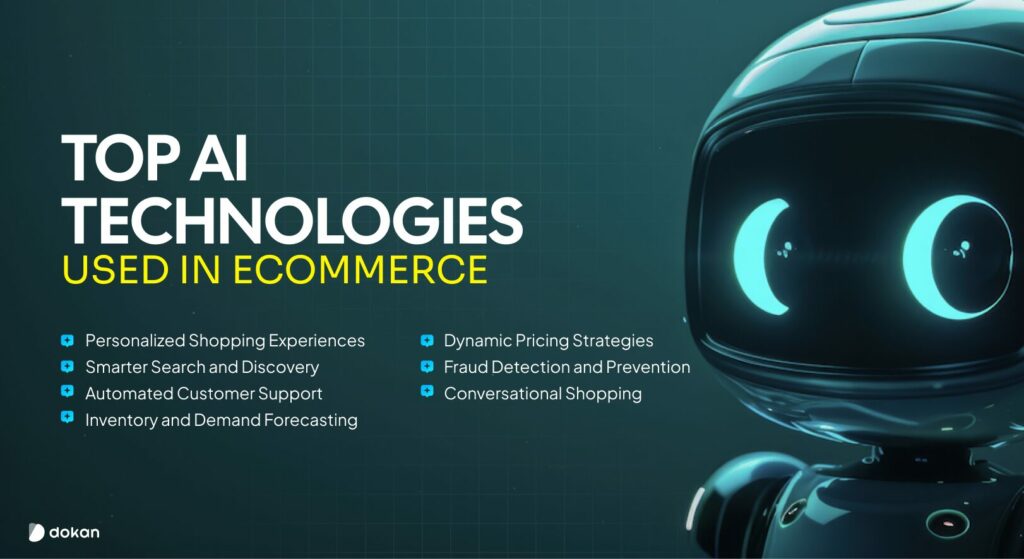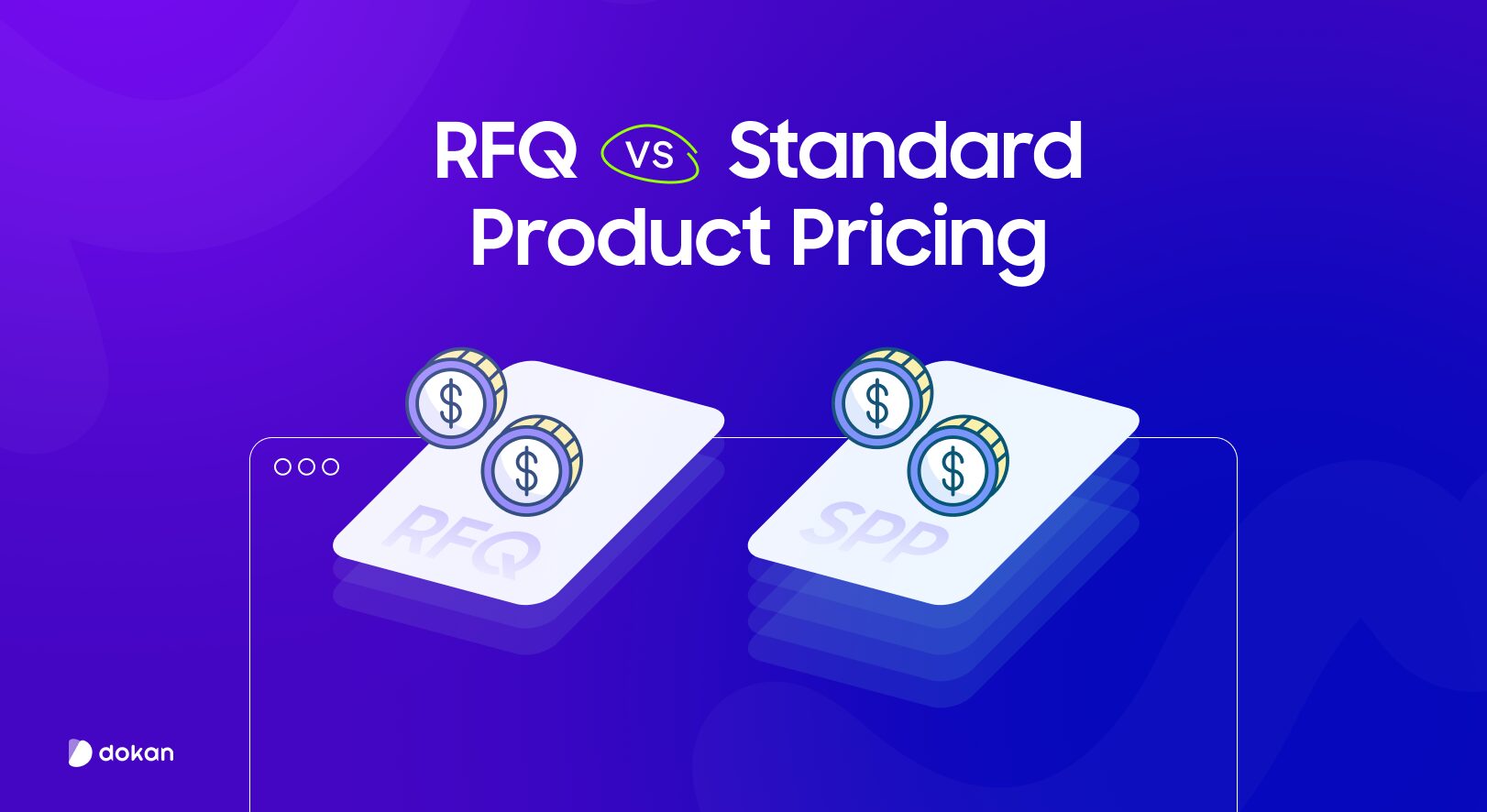The shift toward AI in eCommerce isn’t just a trend, it’s a race.
From delivering personalized shopping experiences to automating customer support and forecasting demand, AI is transforming how online businesses grow and scale.
If you’re still relying on manual systems or traditional marketing tactics, you’re already one step behind.
This guide breaks down how AI is reshaping the eCommerce landscape and why adopting it today could be the most brilliant move for your store’s future.
What Types of AI Technologies Are Powering eCommerce Today
1. Machine Learning (ML)
Machine Learning is the backbone of most AI applications in eCommerce. It enables systems to learn from historical data such as customer behavior, product trends, and sales performance and continually improve over time without requiring explicit programming.
Machine learning (ML) is used in recommendation engines, pricing optimization, churn prediction, and fraud detection. For example, it can learn which products a customer is likely to buy based on past activity and recommend them automatically. As more data becomes available, the predictions become more accurate, enabling you to make smarter, faster decisions.
2. Natural Language Processing (NLP)
NLP allows AI to understand, interpret, and respond to human language. It powers chatbots, virtual assistants, smart search bars, and voice commerce tools. In eCommerce, NLP helps improve customer service by interpreting questions, identifying sentiment, and giving context-aware answers.
NLP also enables you to analyze customer reviews at scale, extracting valuable feedback and emotional insights. By bridging the gap between human communication and machine understanding, NLP makes digital shopping more conversational and accessible.
3. Computer Vision
Computer Vision enables machines to “see” and interpret images or videos crucial in visual search, product tagging, and quality control. For instance, customers can upload a photo of an item they like, and AI can instantly suggest similar products in your store.
Computer vision is also used to detect defects in product images, enhance AR experiences (like virtual try-ons), and improve catalog management through automated image classification. This technology helps you deliver a visually intuitive shopping experience and reduce manual visual-related tasks.
4. Generative AI
Generative AI creates new content, such as product descriptions, email copy, and chatbot responses, based on learned patterns. It’s especially useful for automating repetitive content creation while maintaining contextually relevant and brand-aligned content.
The future of sales is to serve, not sell. Generative AI gives us guidance that’s so personal and precise, we’re always presenting the most relevant solutions — no pushing required.
— Marcus Chan, president and founder of Venli Consulting Group
Tools like ChatGPT or Jasper can write personalized messages, SEO-friendly text, or even generate AI-driven conversations with shoppers. In eCommerce, this leads to faster content production, improved personalization, and better scaling of marketing and customer communication. Generative AI helps you keep your store dynamic without adding manual workload.
5. Predictive Analytics
Predictive analytics uses statistical algorithms and ML to forecast future events based on historical data. It’s widely used in inventory forecasting, customer behavior prediction, and sales trend analysis. For example, it can tell you which products are likely to go out of stock soon or which customers are likely to churn.
This foresight enables you to act proactively, ordering inventory in advance or sending retention emails before you lose a customer. In a fast-moving eCommerce environment, this gives you a strategic edge.
6. Recommendation Systems
Recommendation engines are a specialized AI technology that suggests products to users based on preferences, browsing behavior, and past purchases. These systems use a combination of collaborative filtering (what similar users liked) and content-based filtering (product attributes) to display relevant suggestions. Consider how Amazon suggests “frequently bought together” or “customers also viewed” items.
Recommendation system technology, powered by AI, increases conversion rates, enhances cross-sell and upsell opportunities, and improves customer satisfaction. With personalized recommendations, your shoppers feel recognized and understood.
Do You Need an AI Agent for eCommerce Marketing Success?
As competition grows and customer expectations rise, manual marketing strategies are no longer enough. AI agents can automate tasks, analyze data more efficiently, and personalize campaigns at scale, giving your business a genuine competitive edge. Let’s explore whether bringing AI into your marketing stack is the smart next step.
You’ve already heard of AI tools that help with content, ads, or chatbots. However, the game is changing rapidly with the advent of AI agents.
An AI agent is a system that –
Think of AI agents as your digital marketing assistants who don’t just follow instructions. They act, learn, and improve based on goals and real-time data. While traditional automation tools need constant human setup, AI agents can make decisions and handle complex marketing tasks with little to no manual effort.
It’s more than a tool! It’s an intelligent teammate for your business.
How AI Agents Work in eCommerce
AI agents in eCommerce work by analyzing customer data, behavior, and preferences in real time to automate tasks like product recommendations, chat support, personalized emails, and dynamic pricing. They act as smart assistants that continuously learn and adapt to deliver faster, more relevant, and more efficient shopping experiences.
Here’s how you can use AI agents in your store’s day-to-day marketing:
| Task | What the AI Agent Does |
| Ads | Creates and adjusts Meta or Google campaigns to optimize ROAS |
| Product Suggestions | Recommends personalized products for each user |
| Email Campaigns | Sends the right email at the right time based on behavior |
| Discounts & Offers | Creates custom bundles or discounts to close more sales |
| Customer Service | Handles FAQs, order tracking, returns via chat |
| Retargeting | Brings back abandoned cart users with personalized follow-ups |
All of this, on autopilot.
Real Tools to Try Right Now
You don’t need a developer or a big budget. Here are fundamental AI agent tools you can start with:
- Shopify Sidekick (Coming Soon): Shopify’s built-in AI agent can help you manage your store, suggest marketing actions, and even write product descriptions.
- Meta Advantage+ Shopping Campaigns: Meta’s AI automatically tests creatives, placements, and targeting to drive more conversions. You set the budget—it handles the rest.
- Klaviyo AI: Send behavior-based emails or SMS at the perfect time with AI. Example: Someone visits your site three times → receives a discount code sent automatically.
- Tidio AI + GPT: Build an intelligent chatbot that acts like a customer service rep—answers questions, recommends products, and even upsells.
- Zapier AI Agents: Set up automation that triggers when customers take specific actions, such as sending a thank-you email after purchase or triggering upsells when they browse but don’t make a purchase.
Why It Matters for You
Using AI agents helps your store:
And they work 24/7! Eeven when you sleep.
Why Should You Use Artificial Intelligence in eCommerce Companies?
AI is no longer optional. It’s a competitive necessity for eCommerce brands aiming to scale, personalize, and operate efficiently. The core logic behind adopting AI lies in its ability to transform data into actionable insights, automate complex tasks, and optimize every touchpoint in the buyer’s journey.
1. Increased Revenue Through Personalization
AI helps deliver personalized product recommendations, which significantly boost conversion rates. According to McKinsey, personalization can reduce acquisition costs by up to 50%, lift revenues by 5–15%, and increase marketing ROI by 10–30%.
2. Better Customer Experience and Support
AI-powered chatbots and virtual assistants provide instant, 24/7 support, reducing customer wait times. A report by Intercom Research found that Chatbots increased sales by an average of 67%, with 26% of all sales starting through a chatbot interaction.
3. Operational Efficiency and Cost Savings
AI automates tasks such as inventory management, demand forecasting, and dynamic pricing, thereby reducing human error and increasing efficiency. AI automation can recover 26% of abandoned carts, eliminating the need for manual follow-ups to reconnect with customers.
4. Real-Time Decision Making
AI enables dynamic pricing and fraud detection by analyzing vast amounts of data in real-time, something humans cannot do at scale.
Despite 88% of companies recognizing the importance of real-time decision-making, only 39% are investing in it, mainly due to confusion over what real-time truly means and how to implement it effectively.
5. Improved Customer Retention
AI empowers you to gain a deep understanding of customer behavior by analyzing purchase history, browsing patterns, feedback, and engagement levels. With this insight, you can identify which customers are at risk of churning and understand the reasons behind it. Instead of reacting after they leave, AI allows you to take proactive steps, such as sending personalized offers, re-engagement emails, or loyalty incentives, at just the right time.
6. Scalability Without Hiring Costs
AI tools enable eCommerce companies to scale their operations without the need to increase headcount exponentially.
Businesses that scale with AI save an average of 20–30% on operational costs compared to those that rely solely on human teams. According to SHRM, 88% of companies utilize AI in HR, with 40% using it for screening and 41% employing chatbots, but despite growing adoption, scaling AI across departments remains a key challenge.
Top AI Use Cases for eCommerce

AI is reshaping eCommerce by making it faster, smarter, and more personalized. From automating customer support to predicting demand and personalizing shopping experiences, AI is helping businesses boost efficiency, increase sales, and deliver better customer journeys.
1. Personalized Shopping Experiences
AI is redefining how online stores engage with customers by delivering hyper-personalized experiences. Instead of offering the same layout or recommendations to everyone, AI tailors each interaction based on individual behavior and preferences.
How It Works
AI-powered personalization utilizes machine learning algorithms to process vast amounts of customer data, including browsing history, purchase behavior, location, device type, demographics, and the time spent on product pages. It then builds dynamic customer profiles and predicts what each shopper is most likely to want or need. Based on this, it customizes everything from homepage banners and product recommendations to email campaigns and retargeting ads.
For example:
This real-time customization enables eCommerce businesses to engage users more effectively,
boosting both satisfaction and sales.
Benefits of AI-powered Personalization in eCommerce
- Higher conversion rates – Personalized product suggestions increase the chances of a purchase.
- Improved customer retention – Shoppers are more likely to return when they feel understood and valued.
- Increased average order value (AOV) – AI can cross-sell and upsell effectively by recommending complementary or premium products.
- Lower bounce rates – Relevant content keeps users engaged longer and reduces site exits.
- More innovative email marketing – AI can segment users and deliver personalized campaigns that drive more clicks and revenue.
- Better customer experience – Shoppers get a curated experience, making them feel like the store was designed just for them.
2. Smarter Search and Discovery
AI is revolutionizing how customers find products in eCommerce stores by making the search process faster, more accurate, and intuitive. Instead of relying on exact keyword matches, AI-powered search understands user intent, context, and even visual cues to deliver better results.
How It Works
AI enhances search functionality using Natural Language Processing (NLP), image recognition, and behavior analysis. NLP allows search engines to interpret conversational or vague queries, spelling errors, and synonyms. For example, if a user types “comfy office chair for back pain,” AI understands the intent and shows ergonomic chair options—even if the product titles don’t use the exact same words.
AI also enables visual search, where users can upload an image to find similar products. This is especially powerful in fashion, home decor, and lifestyle categories. Additionally, AI tracks what users click, filter, or dwell on during browsing to refine future search results dynamically.
Examples include:
Benefits of AI-powered Search and Discovery in eCommerce
- Faster product discovery – Helps users find what they want quickly, even with complex or unclear queries.
- Higher conversion rates – Accurate and relevant search results increase the chances of purchases.
- Improved mobile shopping experience – Visual and voice search reduce friction on smaller screens.
- More intuitive navigation – AI adapts search results based on real-time behavior, improving usability.
- Reduced no-result pages – Smart suggestions and autocomplete features prevent dead-end searches.
- Enhanced customer satisfaction – A seamless and intelligent search journey keeps users engaged and coming back.
3. Automated Customer Support
AI is transforming customer support in eCommerce by offering instant, 24/7 assistance through intelligent automation. This not only improves response time but also reduces the burden on human support teams, while maintaining a high level of service quality.
How It Works
AI-driven customer support primarily relies on chatbots, virtual assistants, and AI-based helpdesk systems. These tools utilize Natural Language Processing (NLP) to understand customer queries in real time, regardless of how they’re phrased. Basic inquiries like “Where is my order?”, “How do I return a product?” or “Do you ship internationally?” are answered instantly without human involvement.
Advanced systems are also integrated with backend data (like order tracking or user profiles), allowing bots to fetch personalized answers, for example, tracking a specific order or processing a return request automatically. If the question is too complex, the AI seamlessly transfers the query to a human agent with full context.
Examples include:
Benefits of AI-powered Customer Support in eCommerce
- 24/7 availability – Customers get help anytime, even outside business hours.
- Faster response time – Instant replies reduce waiting and improve satisfaction.
- Lower support costs – Fewer agents are needed as bots handle repetitive queries.
- Scalable service – Easily manage support during high-traffic events like sales or holidays.
- Seamless escalation – AI routes complex issues to the right agent with a full conversation history.
- Consistent experience – Responses are always accurate, polite, and aligned with brand tone.
4. Inventory and Demand Forecasting
AI is helping eCommerce businesses move from reactive stock management to proactive inventory planning. With intelligent forecasting, companies can stock the right products at the right time, reducing both shortages and excess inventory.
How It Works
AI-powered demand forecasting systems analyze historical sales data, seasonal trends, website traffic, marketing campaigns, market conditions, and external factors such as holidays or weather. Machine learning models identify patterns and predict future demand for each product across different periods and regions.
This allows businesses to optimize purchase orders, warehouse space, and supply chain operations. AI can also detect sudden demand spikes or drops and adjust forecasts in real-time, reducing risk and improving agility.
Examples include:
Benefits of AI-powered Inventory and Demand Forecasting
- Reduced stockouts – Predict demand accurately and keep best-sellers available.
- Lower holding costs – Avoid overstocking and cut storage expenses.
- Improved cash flow – Invest in inventory that is more likely to sell, not sit.
- Faster restocking – Detect low inventory early and automate reordering to minimize downtime.
- More innovative warehouse planning – Know what products to store where based on local demand.
- Increased customer satisfaction – Customers find what they want when they want it, with fewer “out of stock” issues.
5. Dynamic Pricing Strategies
AI is changing how eCommerce stores set prices by enabling dynamic pricing and real-time adjustments based on multiple factors. Instead of static pricing, businesses can now respond instantly to market conditions, competitor moves, and customer behavior.
How It Works
AI-powered pricing engines analyze data such as competitor prices, customer demand, inventory levels, historical sales, time of day, and user behavior. Machine learning models then suggest or automatically apply optimal prices that maximize profit or conversions.
For example, if a competitor lowers their price or a product becomes trending, the AI can respond immediately, either by adjusting the cost to stay competitive or increasing it when demand surges. These systems also personalize pricing based on user segments, geography, or device type, enabling targeted discounting or premium positioning.
Examples include:
Benefits of AI-powered Dynamic Pricing in eCommerce
- Maximized profits – Prices are optimized to capture maximum revenue based on real-time data.
- Improved competitiveness – React instantly to market changes and undercut rivals when needed.
- Better inventory control – Slow-moving products can be discounted to clear stock efficiently and effectively.
- Personalized pricing – Offer targeted deals based on user behavior or segment.
- Higher conversion rates – Competitive pricing encourages quicker purchases.
- Real-time adaptability – AI learns and updates pricing strategies continuously to reflect evolving conditions.
6. Fraud Detection and Prevention
AI plays a critical role in protecting eCommerce businesses and customers from fraud. By analyzing patterns and identifying anomalies in real-time, AI can detect and stop the suspicious activity before it causes financial or reputational damage.
How It Works
AI-based fraud detection systems utilize machine learning to analyze vast datasets of past transactions, including both legitimate and fraudulent ones. These models learn what normal behavior looks like (e.g., order size, payment method, location, device) and flag any unusual activity that deviates from those patterns.
For instance, if a user suddenly places multiple high-value orders from a new IP address or uses various cards within a short timeframe, the AI can pause the transaction or send it for manual review. Over time, the system gets smarter by continuously learning from new data and confirmed fraud cases.
Examples include:
Benefits of AI-powered Fraud Detection in eCommerce
- Real-time threat detection – Identify and block suspicious transactions instantly.
- Reduced chargebacks – Prevent fraudulent purchases that lead to costly disputes.
- Improved trust and security – Protect your brand and customers from fraud-related issues.
- More innovative risk scoring – Automatically flag high-risk orders for review without affecting good customers.
- Continuous learning – AI systems evolve with new fraud trends and stay ahead of attackers.
- Lower operational costs – Reduce the need for manual fraud review and investigation.
7. Conversational Shopping
Conversational shopping powered by AI is redefining the online buying experience by making it feel more like a dialogue than a transaction. Instead of just browsing, customers can now engage in real-time conversations—asking questions, receiving personalized suggestions, and making decisions more quickly with the help of intelligent assistants.
How It Works
AI-driven conversational commerce uses chatbots, voice assistants, and now generative AI to simulate human-like conversations throughout the customer journey. These systems integrate with your product database, CRM, and analytics tools to respond to complex questions, guide users through purchase decisions, and even initiate follow-ups based on cart behavior or retargeting data.
With the rise of generative AI, chatbots can now engage in more in-depth, contextually relevant conversations. Shoppers can ask things like, “What shoes go with this dress?” or “Is this available in my size for delivery by Friday?” and receive real-time, accurate answers—24/7. These AI agents can also assist across the entire site, from product search and filtering to checkout and order tracking.
Examples include:
Benefits of Conversational Shopping
- Talk to Every Shopper in Real Time – Guide your customers as they shop, answer questions, resolve objections, and boost conversions without delay.
- Show Products They Actually Want – Conversational AI recommends products based on behavior in the moment, making every suggestion feel personal and relevant
- Be There Even When You Sleep – With 24/7 chatbots and assistants, you never miss a chance to help a customer or close a sale day or night
- No More Friction at Checkout – AI can walk customers through sizing stock or shipping right inside the chat, so they buy faster with fewer doubts
- Build Loyalty Through Real Conversations – People remember brands that listen and respond in real time. It turns one-time shoppers into repeat buyers
- Learn What Your Customers Really Want – Every chat tells you something new. Use that data to improve your site offers and campaigns with confidence
8. Visual Search
If your customers don’t know the right words to describe what they want, AI-powered visual search can help them find products just by uploading a photo. This makes product discovery effortless and keeps users engaged, particularly in categories such as fashion, home decor, and accessories.
9. Voice Commerce
With more consumers using voice assistants like Alexa or Google Assistant, enabling voice search lets you tap into hands-free shopping. It makes browsing faster and more accessible, especially for mobile users or multitaskers—offering a smoother buying experience.
10. AI-Powered Product Tagging
Manually tagging products with color, size, style, or material is a time-consuming and inconsistent process. AI automates this task for you, improving product filtering and SEO while keeping your catalog organized and up to date with minimal effort.
11. Smart Retargeting Ads
You’re likely spending money on ads that miss the mark. AI utilizes behavioral data to target the right users with personalized ad content, maximizing ROI by displaying the right message at the right time, without requiring constant manual adjustments.
12. Churn Prediction
Retaining customers is often more cost-effective than acquiring new ones, and AI helps you stay ahead by identifying users who are likely to stop purchasing from you. With this insight, you can take action early, offering incentives or sending timely emails to win them back.
13. Smart Product Bundling
Instead of offering random combos, AI helps you suggest product bundles based on actual customer behavior. This increases your average order value and enhances the shopping experience by displaying relevant add-ons that customers might not consider on their own.
14. Personalized Email Campaigns
Generic emails often get ignored. With AI, you can send content that feels made just for each customer, based on their past activity, preferences, or browsing behavior. It increases engagement, boosts repeat purchases, and makes your emails feel human, not automated.
15. Predictive Customer Lifetime Value (CLV)
Knowing which customers bring the most value over time helps you focus your marketing and support where it matters. AI can predict this for you, allowing you to spend smarter, build loyalty with high-value customers, and avoid wasting resources on one-time buyers.
16. AI-Powered Search Autocomplete
When users search your site, speed and accuracy matter. AI-driven autocomplete helps them find what they want faster by predicting their intent as they type, which reduces drop-offs and boosts your search-to-sale conversion rate.
17. Return Prediction
If returns are eating into your profit, AI can help by identifying patterns that lead to frequent returns, such as product types, sizes, or customer segments. You can then identify and address the root cause, provide more accurate sizing information, or even proactively flag high-risk transactions.
18. AI-Based Loyalty Program Optimization
Not all customers are motivated by the same rewards. AI helps you personalize loyalty programs so each shopper receives offers and incentives that match their habits, making them more likely to return and spend again.
19. Emotion Analysis from Reviews
Customer reviews often reveal more than star ratings. AI can read between the lines and detect emotional tone, helping you understand real pain points or product strengths. You’ll get insights at scale that would take hours to gather manually.
20. Automated Product Descriptions
If writing descriptions for every product slows you down, AI can do it faster, generating explicit, SEO-optimized content in seconds. This saves time and keeps your product listings consistent, which helps both users and search engines.
21. Dynamic UX Personalization
Every visitor to your site behaves differently. AI enables you to customize the site experience in real time, showing tailored banners, recommended products, and layout adjustments that reflect each user’s journey, making your store feel personal and intuitive.
22. Inventory Risk Alerts
Running out of best-sellers or overstocking slow movers can cost you sales or warehouse space. AI monitors your inventory in real time and alerts you when stock levels reach critical zones, allowing you to restock or scale back before problems arise.
FAQs on AI for eCommerce
How is AI used in eCommerce right now?
AI is used across multiple touch points in eCommerce, from powering product recommendations and chatbots to automating inventory management and generating SEO content. It helps brands personalize shopping experiences, detect fraud, and even predict demand, making operations more data-driven and efficient.
Can AI really improve customer retention for my online store?
Yes. AI analyzes patterns like purchase frequency, cart abandonment, and support interactions to identify customers at risk of leaving. You can then trigger personalized retention campaigns, such as discounts, reminders, or loyalty perks, automatically leading to a higher lifetime value.
What makes AI-powered product recommendations more effective than manual ones?
Unlike manual setups, AI recommendations are driven by real-time user behavior, purchase history, and similar user patterns. This creates hyper-relevant suggestions that adapt dynamically, often increasing conversion rates by up to 20%.
Is generative AI safe to use for creating product descriptions and landing pages?
It is safe when appropriately reviewed. Generative AI tools can create scalable and SEO-friendly product content, but human editing remains crucial to ensure factual accuracy, consistency of tone, and compliance with search engine guidelines.
How do AI chatbots improve customer service in eCommerce?
AI chatbots handle common questions instantly, such as tracking orders or recommending products, reducing wait times and freeing up your support team. With advancements in generative AI, bots can now understand complex queries and engage in multi-step conversations, much like human agents.
How can AI help reduce operational costs in eCommerce?
AI reduces overhead by automating repetitive tasks such as restock alerts, dynamic pricing, fraud detection, and email marketing. This not only saves time but also improves accuracy and reduces costly human errors.
What is real-time AI decision-making, and why does it matter in eCommerce?
Real-time AI decision-making enables instantaneous responses to customer actions, such as displaying a special offer when a customer hesitates at checkout. Despite 88% of companies valuing it, only 39% invest in it often due to confusion around how to implement it properly.
Can AI help small or mid-sized eCommerce businesses, or is it just for big brands?
Absolutely. Many affordable AI tools are built for SMBs and offer plug-and-play integrations with platforms like Shopify, WooCommerce, and BigCommerce. You can start with product recommendations or email automation, then scale as your business grows.
How do I measure the ROI of AI tools in eCommerce
Track metrics like conversion rate lift, cart abandonment reduction, support ticket volume, and organic traffic growth (for content AI). Most tools offer dashboards, and you can integrate them with Google Analytics to compare performance before and after AI adoption.
What are the risks of using AI in my eCommerce strategy
Risks include over-reliance on automation, generating inaccurate content, or poor personalization due to inconsistent or incomplete data. The key is to utilize AI as an assistant, not a replacement, and combine its power with your domain expertise for optimal results.
Final Words
AI is no longer a futuristic concept; it is a reality. It’s a practical tool that drives real results in eCommerce today.
Whether you’re aiming to streamline operations or create personalized customer experiences, AI offers a competitive edge.
The sooner you implement it, the faster you’ll see smarter growth.
Subscribe to
Dokan blog
We send weekly newsletters, no spam for sure!







Leave a Reply